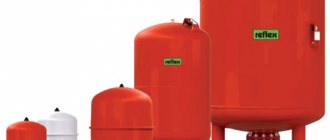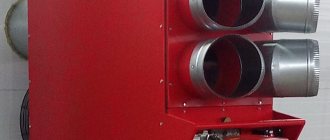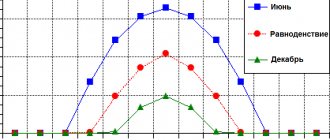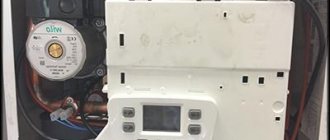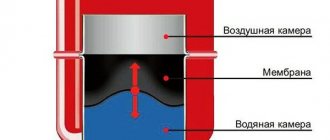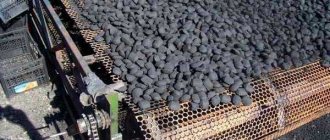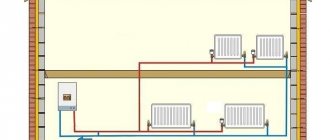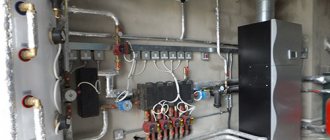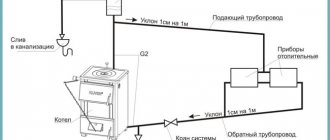Why is an expansion tank needed?
It is well known to everyone from the school physics course that any body expands when heated, and liquids and gases increase in volume. Unlike gas, liquid is an incompressible medium, and if it is heated in a closed vessel, such as a boiler tank, this will lead to an increase in pressure inside it, since there is nowhere for it to expand. As a result, the tank walls may rupture.
Imagine a coolant heated in pipelines from a temperature of 20 ºС to 80 ºС. If you do not install an expansion tank in the heating system, then when the liquid medium is heated, the pressure in the network will increase greatly and water may break out at the weakest point. It's good to have a safety valve. The excess water will go through it, since it has nowhere else to go. If there is no valve, the coolant will simply break out at one of the connections.
An expansion tank is needed to accommodate the growing coolant as it heats up. At the same time, during cooling it returns back to the system.
In the case when the safety valve releases water, after cooling it cannot return it back and will allow air to fill the vacated space. This will lead to the formation of an air lock, which will prevent the system from working normally.
Main tank volume
This parameter is calculated in several ways. The simplest solution is to take 10-15% of the total volume of the heating system (if water is used as the coolant). As a result, for a network with a capacity of 100 liters you will need a 10-6.6 liter tank. If the role of the coolant is played by a non-freezing liquid, then the resulting figure increases by 50%. The end result is 15-9.9 liters.
Another option is to multiply the volume of the heating system by 0.08. In this case, the required tank capacity will be 8 liters (for a network with a volume of 100 liters). The disadvantage of such a calculation is that the data is approximate and can only serve as a guide when choosing a tank.
You can also use special online calculators that will give more accurate numbers. It is advisable to perform calculations on several sites to ensure that the results obtained are correct. Calculation using formulas is more difficult because it requires special care. It is also worth using different formulas to check data.
Professional calculations are carried out by specialists who take into account a wide range of factors (water volume, expansion coefficient, tank efficiency). This is the most accurate, but most expensive method. An error in calculations can lead to malfunctions of the heating system.
Important: the higher the maximum coolant temperature in the heating system, the higher the capacity of the expansion tank. Increasing the maximum permissible pressure in the network allows you to reduce the volume of the tank.
The volume of the heat accumulator is calculated differently: for 1 kW of heating boiler power, 23-26 liters of water are required. Other sources give a different ratio: 1 kW – 50 liters. This is a rough estimate. When calculating the tank capacity, specialists take into account the boiler power (kW), boiler efficiency, active fuel combustion time and other data.
Types of expansion tanks
Externally, expansion tanks for heating may differ in shape and size, determined by calculation. Typically this is a tank connected to the heating system via a single pipe. However, different types of containers have design differences, and they are used in different cases. To choose the right tank, you need to understand these differences, so first we present a list of existing types:
- open type;
- closed, equipped with a membrane.
Note. There are also closed expansion vessels without a membrane, but their use is strictly not recommended. We'll explain why below.
Open type containers
These tanks are used for an open heating system (otherwise known as gravity, gravity) and are a metal tank with an open top of any shape. A pipe for connecting a hose or overflow pipe is welded to the upper part of the side wall; the coolant is supplied to the tank from below. The element is installed above the entire system on the supply pipeline, usually in the attic of the house.
Note. In correct technical language, an open system is one from which water is directly taken for the needs of hot water supply. It is not used in private homes, only in centralized networks. A scheme with natural coolant circulation is mistakenly called open.
Any expansion tank for open type heating performs 2 functions:
- serves to compensate for the expansion of the coolant;
- removes air from the system, since its top communicates with the atmosphere.
This is its advantage, but it is not the only one. An open container can also successfully and durablely serve in systems with forced circulation, since the design of the tank is very simple, there is nothing to break. However, it also has many disadvantages:
- a tank installed in the attic requires good insulation;
- During the season, it is necessary to constantly monitor the water level in the tank and replenish it in a timely manner;
- the coolant is constantly saturated with oxygen from the atmosphere, which is why the metal parts of the boiler corrode faster;
- additional consumption of materials and difficulties during installation.
About closing systems and tanks
A closed expansion tank is free from all of the above disadvantages. Yes, and it works completely differently. At the same time, it performs only one function - it is compensation for the expansion of the coolant. It has a more complex design and you won’t be able to make it yourself. It consists of two parts:
- air tank;
- chamber for liquid.
These parts are located in a sealed metal case; contact between them is completely eliminated thanks to a rubber membrane. Each part performs its own function. The air tank must maintain a certain pressure. There is a nipple at the top of it. With its help, you can deflate or pump up air using an ordinary pump, preferably with a pressure gauge. The liquid chamber is connected to the circuit. Before choosing an expansion tank for a heating system, you need to know the main requirement for the liquid chamber - its volume. A very important indicator on which the performance of the entire system directly depends.
Principle of operation
To understand how to choose an expansion tank for a heating system, let’s understand the principle of its operation. A certain amount of coolant circulates in the heating circuit. And this amount should always be the same. The problem is that when heated, it increases in volume, and accordingly, the pressure in the circuit also increases. Part of the coolant must be removed from the circuit. In this case, after cooling, the water in the circuit will not be enough. This means that the withdrawn coolant must be returned. Therefore, before choosing an expansion tank for the heating system, you need to decide on its capacity.
Selecting an expansion tank for a heating system is just the beginning; it is important to correctly regulate the amount of air in it. If it is configured correctly, liquid will enter the chamber and stretch the membrane. At the same time, the air pressure in the air chamber will increase. The water will remain in the tank until the temperature in the circuit drops and the liquid decreases in volume. After this, the coolant will be squeezed out by the membrane back into the pipes.
Before connecting the expansion tank to the heating system, it must be adjusted correctly.
Closed membrane tank
A more modern closed expansion tank is a cylindrical vessel with a rubber membrane built inside. It is used in circuits with forced circulation of coolant and is installed in the combustion room. The coolant is also supplied from below; a service spool for pumping air is installed on top of the device.
The rubber membrane (in common parlance – “pear”), which is equipped with a closed expansion tank of the heating system, comes in 2 types:
- in the form of a diaphragm;
- balloon type.
Note. Some manufacturers' containers have a removable bulb, which makes it possible to change it if cracks appear.
The shape of the membrane does not have a special effect on the operation of the device, although the second type of tank holds a little more water. On the other hand, air (sometimes nitrogen) is pumped from the “pear” under a certain pressure; it must be adjusted individually for each system. All closed expansion tanks operate equally simply: when the coolant heats up, the pressure in the network increases, the membrane stretches and releases water inside the tank. When it cools, everything proceeds in the reverse order.
A sealed expansion tank for a wall-mounted gas boiler is often built inside the heat generator, as it is small in size. In addition, the apparatus does not communicate with the atmosphere and the diffusion of oxygen into the coolant is completely excluded. The weak point of such tanks is the membrane; its service life very rarely reaches 10 years, and it is not always possible to replace it.
There is a third type of compensation device - a vacuum expansion tank for closed-type heating without a “pear”. It is difficult to find them on sale, and there is no point, since this design is the most unfortunate. The role of the membrane in the container is played by the air itself, which leads to its active diffusion into the water, and this is unacceptable. And then, the level in the tank will increase all the time, as a result there will be nowhere to compensate for the expansion.
Where to place the expansion tank in a closed heating system?
By the way, in private houses there are no open and closed systems; there are gravity and pressure (pump) systems. In the first, water moves due to the difference in specific gravity (natural circulation), and in the second, it is forced by a pump.
For reference. An open system works simultaneously for heating and hot water supply, and is used only in large centralized networks. This is why all individual systems are closed.
To correctly install the expansion tank in the heating system, the following requirements must be met:
- the location of the tank is the combustion room, not far from the boiler;
- the device must be placed in a place where it can be easily accessed for setup and maintenance;
- if the tank is mounted to the wall on a bracket, it is recommended to maintain a height convenient for access to its air valve and shut-off valves;
- The supply pipe together with the taps should not load the expansion tank with its weight. That is, the eyeliner should be attached to the wall separately;
- the supply line to the floor expansion tank for heating is not allowed to be laid across the floor across the passage;
- Do not place the container close to the wall; leave enough clearance for inspection.
Tanks of small capacity can be hung from the wall, provided that its load-bearing capacity is sufficient. As for the orientation of the tank in space, there is a lot of conflicting advice. Some recommend an installation method in which the pipe is connected to the container from above, and the air chamber, accordingly, is located below. Rationale - it is easier to remove air from under the membrane when filling; water will displace it.
In fact, in its original state, the rubber “bulb”, pressed on one side by air pressure, leaves no room for it on the other side, as shown in the photo above. Installation specialists advise installing the expansion tank with the connecting pipe downwards, and only this way. In some models, the fitting is initially located on the side wall, in its lower part, and it is impossible to position the vessel differently (see photo below).
It's easy to explain. The device will function in any position, even lying on its side. Another thing is that sooner or later cracks will appear in the membrane. When the membrane expansion tank is installed with the air chamber up and the pipe down, the air will penetrate through the cracks into the coolant very slowly and the tank will last for some time. If it stands upside down, then the air, being lighter than water, will quickly flow into the coolant chamber and the tank will have to be urgently changed.
Note. Some manufacturers suggest installing the expansion tank of the heating system by hanging it “head down” on a bracket. This is not prohibited, everything will work, only if the membrane malfunctions, the unit will fail immediately.
Recommendations for selection
If a natural circulation circuit is planned or has already been installed in the house, then an open-type expansion tank is just for you. There is no point in playing tricks with a vacuum tank; remember that water in such a system moves only due to the difference in specific gravity and the device may not play its role. You can buy an open vessel, or you can make it yourself; the main thing is to correctly calculate the volume of the expansion tank, which we will discuss below.
With vacuum membrane vessels the situation is a little more complicated. There is one caveat: if you find yourself in a store among many similar products, do not confuse a heating tank with a hydraulic accumulator for water supply. Outwardly, they are very similar, even the color can be the same, so selecting a tank based on this criterion is excluded. The tanks differ according to the inscription on the nameplate; for heating, the operating temperature is indicated up to 120 ºС and pressure up to 3 Bar. On the hydraulic accumulator, respectively, up to 70 ºС and pressure up to 10 Bar.
When making a choice, it is also worth paying attention to the possibility of replacing the “pear” in case of its failure. The size of the device is selected based on the calculation results of a closed tank.
Setup Guidelines
After installation and insertion of the device into the heating network, it is required to configure it. It is to provide the necessary pressure in the air chamber to match your system. This is necessary to avoid water hammer in the network; they can be created by the membrane of the tank while the coolant cools and its excess is pushed out of the chamber. The operation is performed in the following sequence:
- when the installation of a closed tank is completed, the system is filled with cold water;
- using Mayevsky valves and taps, air pockets are removed from pipes and radiators;
- a pressure gauge measures the pressure in the system, and then in the air chamber of the tank;
- By bleeding or pumping up, the pressure in the chamber is set 0.2 Bar lower than the pressure in the system.
Now that the expansion tank has been correctly installed and then configured, you can start the boiler. The pressure in the container will increase equally smoothly as the coolant heats up and cools down.
Expansion tank calculation
In the technical literature and on the Internet you can find many methods for calculating an expansion tank for a heating system with natural and forced circulation of coolant. But for the most part, they contain a lot of complex formulas linked to the boiler power and other parameters. You can't go wrong if you use a simpler way to determine the volume of the tank.
The method is based on the statement that the amount of water in the system at maximum heating will increase by no more than 5%. That is, first calculate the volume of water as follows:
- the amount of coolant in the boiler tank - according to the passport;
- volume of water in pipelines - using the formula for the area of a circle, find the cross-sectional area of each pipe and multiply it by the length;
- The capacity of the radiators is also according to the product passport.
Having summed up the results, you select and calculate the expansion tank with a margin, taking not 5, but 10% of the resulting amount. This will be its capacity.
Expansion tanks for a closed heating system - selection rules
When purchasing a membrane expansion tank, be guided by the following considerations.
The main criterion for its selection is the volume of the tank. Since heated water expands by approximately 3.5%, when filling, the amount of liquid poured into the circuit is measured and from this data the required capacity of the hydraulic tank is found.
It should also be taken into account that the expansion tank should not be filled completely to increase the service life of the membrane. Also, when using anti-freeze, their thermal expansion is slightly higher than that of ordinary distilled water.
Therefore, it is generally accepted to select the volume of the hydraulic tank to be 10% of the amount of coolant.
Do not forget that some boilers are equipped with an internal small expansion tank. In this case, the external membrane tank is chosen with a slightly smaller capacity, taking into account the internal boiler tank.
Rice. 8 Diagram of correct installation of a membrane hydraulic tank
